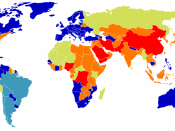The Death Penalty, with opposing viewpoints
The first death penalty laws were first used in the eighteenth century B.C., which was the penalty for 25 different crimes. Death sentences consisted of crucifixion, drowning, beating, and being burnt alive. Hanging was the usual method in Britain in the tenth century A.D. In the sixth century, some common methods were boiling, burning, hanging, and beheading. Some crimes that brought these penalties were marrying a Jew, not confessing to a crime, and treason. By the 1700s, 222 crimes were punishable by death in Britain. It was the country that influenced America to use the death penalty more than any other country. There are currently 38 states in the U.S. with the death penalty. The most common crime is first-degree murder.
Death penalties come at a high price. In Texas, a death penalty case costs taxpayer an average of $2.3 million, which is about three times the cost of 40 years in prison.
California could save $90 million each year by abolishing the death penalty. The cost of sentencing one person to one year in jail averages between $25,000 and $40,000. The annual nationwide cost of building, maintaining, and operating prisons is about $60 billion today. Within 15 years we will be spending more on prisons than we are currently spending on national defense.
Court Cases:
Illinois House Judiciary Committee Votes to Ban Death Penalty
The Illinois House Judiciary Committee voted to abolish the death penalty. After hearing testimony from men who were wrongly sentenced to die for crimes they did not commit, members of the committee voted 8-4 to support the ban. Among those testifying was Illinois death row Gary Gauger, who was wrongly convicted for the murder of his parents. The abolition bill now goes to House floor for consideration. (Associated...



Good
yes
2 out of 2 people found this comment useful.